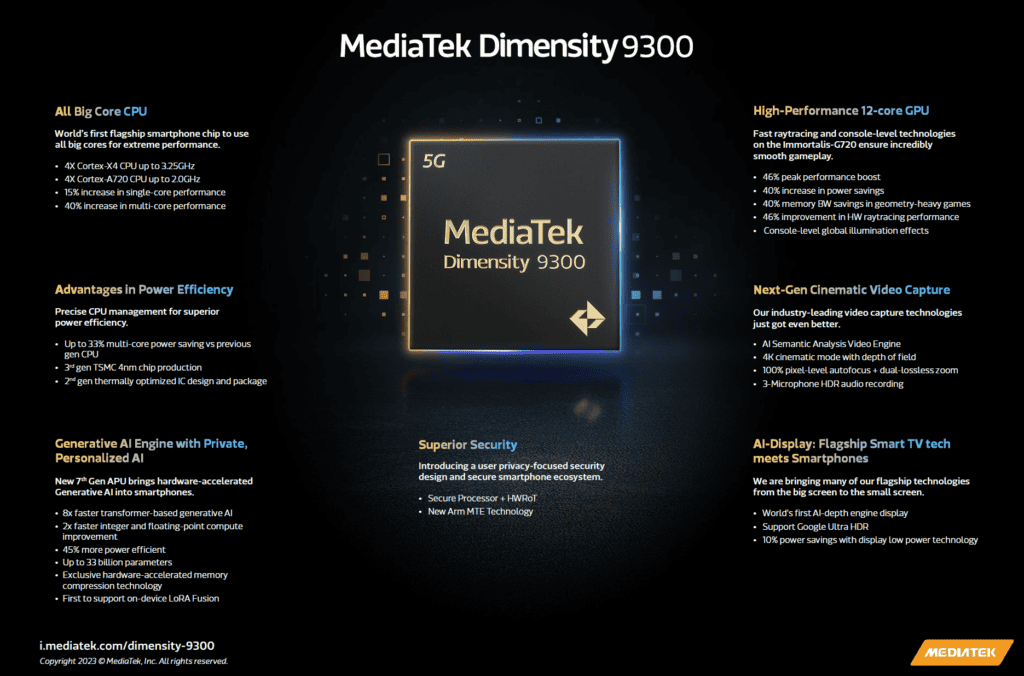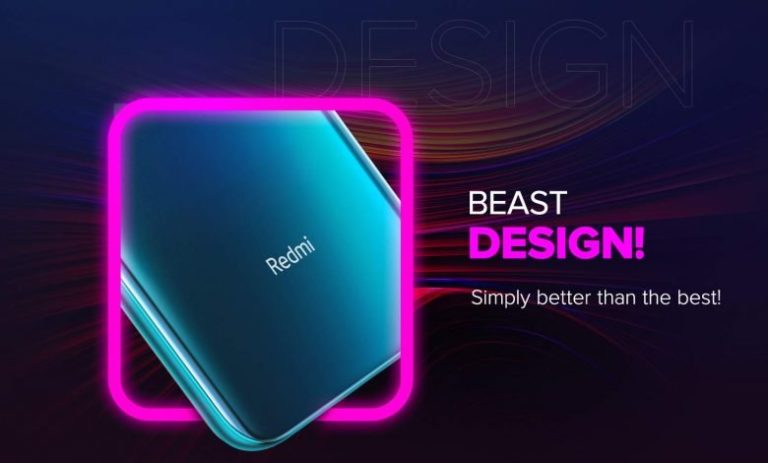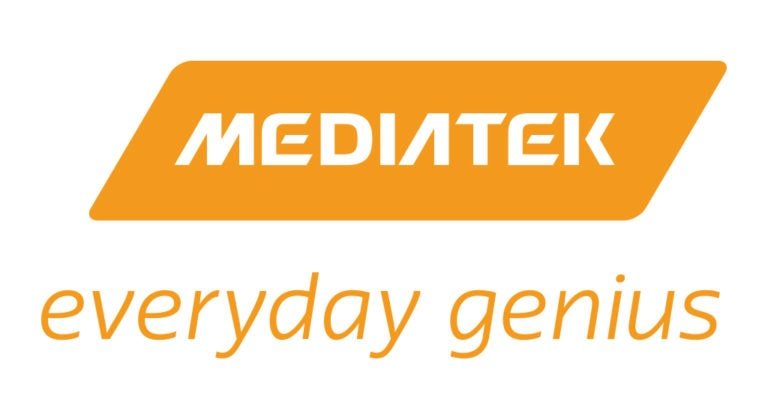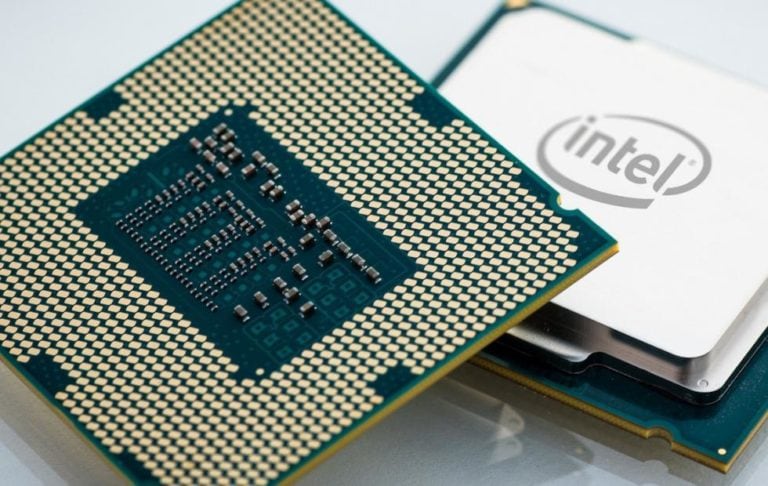Any links to online stores should be assumed to be affiliates. The company or PR agency provides all or most review samples. They have no control over my content, and I provide my honest opinion.
The Mediatek Dimensity 9300 and Qualcomm Snapdragon 8 Gen 3 are the latest flagship mobile phone system-on-chips (SoCs) from MediaTek and Qualcomm respectively. They both use the cutting-edge 4nm manufacturing process and feature advanced CPU, GPU and AI capabilities for top-of-the-line performance.
This comparison analyses the key specifications and expected real-world performance of the Dimensity 9300 and Snapdragon 8 Gen 3 to determine which SoC likely delivers better overall performance and value.
Chipset Specification Comparison
| Snapdragon 8 Gen 3 | Dimensity 9300 | |
|---|---|---|
| CPU Config | 1x 3.3GHz (Cortex-X4) | 1x 3.25GHz (Cortex-X4) |
| 3x 3.2GHz (Cortex-A720) | 3x 2.85GHz (Cortex-X4) | |
| 2x 3GHz (Cortex-A720) | 4x 2GHz (Cortex-A720) | |
| 2x 2.3GHz (Cortex-A520 Refresh) | ||
| GPU | Adreno | Arm Immortalis-G720 MC12 |
| Ray tracing support | Ray tracing support | |
| Global illumination | Global illumination | |
| DSP | Hexagon | APU 790 |
| (fused scalar, tensor, and vector) | INT8/INT16 | |
| Mixed precision INT8/INT16 | INT4 support | |
| INT4 support | ||
| RAM support | LPDDR5X | LPDDR5T |
| Camera | 200MP single shot | 320MP single shot |
| 108MP single with zero shutter lag | HDR video | |
| 64MP+36MP with zero shutter lag | Real-time semantic segmentation for photos and videos (up to 16 layers) | |
| Triple 36MP with zero shutter lag | 8K/30fps | |
| Dolby HDR photo | 4K/60fps | |
| Real-time semantic segmentation for photos and videos (up to 12 layers) | ||
| 8K/30fps HDR video | ||
| 4K/120fps slow-motion | ||
| Charging | Quick Charge 5 | USB-PD PPS |
| 4G/5G Modem | X75 LTE/5G (integrated) | LTE/5G (integrated) |
| 10,000Mbps down | 7,000Mbps down | |
| 3,500Mbps up | ||
| Other networking | Bluetooth 5.4 | Bluetooth 5.4 |
| Wi-Fi 7, Wi-Fi 6/6E (802.11ax), Wi-Fi 5 (802.11ac), 802.11a/b/g/n | Wi-Fi 7, Wi-Fi 6/6E (802.11ax), Wi-Fi 5 (802.11ac), 802.11a/b/g/n | |
| Process | TSMC 4nm (N4P) | TSMC 4nm (4nm+) |
Fabrication Process

Both the Dimensity 9300 and Snapdragon 8 Gen 3 are manufactured on TSMC’s cutting-edge 4nm process node, allowing for improved performance and power efficiency compared to prior generation 7nm and 5nm chips.
The Snapdragon 8 Gen 3 uses TSMC’s N4P node while the Dimensity 9300 uses the refined 4nm+ node. Both deliver similar density and efficiency enhancements, so there is unlikely to be a significant difference from the manufacturing process alone.
CPU
The Dimensity 9300 features a 1+3+4 CPU configuration:
- 1x Cortex X4 Prime core at 3.25GHz
- 3x Cortex X4 performance cores at 2.85GHz
- 4x Cortex A720 efficiency cores at 2GHz
Meanwhile, the Snapdragon 8 Gen 3 has a 1+3+4 setup:
- 1x Cortex X4 Prime core at 3.19GHz
- 3x Cortex A720 performance cores at 2.96GHz
- 4x Cortex A520 efficiency cores at 2.27GHz
MediaTek claims the Dimensity 9300 delivers up to 40% higher multi-threaded CPU performance versus the prior Dimensity 9200, while using 15% less power at the same performance level.
Qualcomm says the Snapdragon 8 Gen 3 CPU is 30% faster than the prior generation Snapdragon 8 Gen 2.
So, while both deliver strong generational improvements, MediaTek asserts the Dimensity 9300 holds a multi-threaded CPU advantage. We’ll need to benchmark real devices to confirm.
GPU
The Snapdragon 8 Gen 3 features the latest Adreno 750 GPU which Qualcomm says is 25% faster and more power efficient than the prior generation Adreno 730.
Meanwhile, the Dimensity 9300 introduces MediaTek’s first high-end mobile GPU – the Arm Immortalis G720 MC12. MediaTek claims it delivers up to 41% faster graphics performance over the prior Mali-G710 in the Dimensity 9200 chip.
MediaTek also asserts the Dimensity 9300 scores 23% higher in the 3DMark Wild Life benchmark versus the Snapdragon 8 Gen 3. We’ll need to validate this claim through testing.
Cache, RAM and Storage
Both chipsets support fast LPDDR5X RAM and UFS 4.0/4.1 storage.
The Snapdragon 8 Gen 3 increases the amount of L3 cache to 12MB, up from 8MB in the prior generation Snapdragon 8 Gen 2 which should aid CPU and GPU performance.
The Dimensity 9300 retains 8MB of L3 cache but adds an extra 4MB of system cache for 10MB total.
AI and Machine Learning
The Snapdragon 8 Gen 3 features Qualcomm’s updated Hexagon processor with a claimed 4.35x increase in AI performance versus the prior generation. This powers new AI capabilities in areas like photography, gaming and connectivity.
Similarly, MediaTek has enhanced the APU in the Dimensity 9300 to deliver up to 6x higher AI performance versus the Dimensity 9200. This brings improvements to camera, video, multimedia and connectivity workloads.
Both chipsets also feature dedicated AI processing hardware to enable features like real-time video bokeh effects. Overall, AI capabilities appear closely matched.
Media Decode
Both chipsets support the latest multimedia codecs and formats including AV1 hardware decoding up to 8K60fps, HDR10+ video, H.264, HEVC, VP9 and more.
Media consumption and creation on devices powered by either SoC should be excellent, with little to separate them.
Connectivity
WiFi & Bluetooth
The Snapdragon 8 Gen 3 and Dimensity 9300 both incorporate WiFi 7 and Bluetooth 5.3 connectivity for the fastest possible wireless speeds and advanced features. This includes speeds up to 5.8Gbps over WiFi 7 along with ultra low latency.
Cellular Modem
The Snapdragon 8 Gen 3 utilizes Qualcomm’s cutting-edge Snapdragon X75 5G modem. This delivers theoretical peak download speeds up to 10Gbps along with advanced carrier aggregation across all key global 5G spectrum bands.
Meanwhile, the Dimensity 9300 has an integrated 5G modem supporting sub-6GHz networks. It tops out at 7Gbps peak downloads and offers mainstream 5G connectivity.
So the Snapdragon 8 Gen 3 delivers faster next-generation mmWave 5G support in applicable markets like the USA, while the Dimensity 9300 still provides fast sub-6GHz 5G suitable for most users globally.
Benchmarks
Early benchmark results highlight the performance capabilities of both chipsets:
Antutu v10
- Snapdragon 8 Gen 3: 1.75 million
- Dimensity 9300: 2.0 million (MediaTek claim, not independently verified)
Geekbench v6
- Snapdragon 8 Gen 3: Single-core: 2563 Multi-core: 7256
- Dimensity 9300: Single-core: 2622 Multi-core: 6244 (MediaTek claim)
3DMark Wild Life
- Snapdragon 8 Gen 3: 13,177
- Dimensity 9300: 14,398 (MediaTek claim)
These benchmarks tentatively suggest the Dimensity 9300 holds the lead in multi-threaded CPU workloads, while graphics performance is potentially on par with the Snapdragon 8 Gen 3. However, we’ll need to validate these findings through hands-on testing.
Gaming Performance

Gaming is a key use case for flagship phone SoCs. Both the Snapdragon 8 Gen 3 and Dimensity 9300 are expected to provide excellent gaming experiences with high frame rates.
However, Qualcomm’s Adreno GPUs have traditionally delivered better gaming optimization and support in demanding game engines like Unreal Engine and Unity. So the Snapdragon 8 Gen 3 may have an edge for gaming enthusiasts.
Thermal Throttling
The Snapdragon 8 Gen 3 is manufactured on TSMC’s 4nm process and features a 10-layer 3D passive cooling system for dissipating heat. This should minimize thermal throttling.
Likewise, the 4nm Dimensity 9300 incorporates MediaTek’s enhanced thermal design to reduce overheating and clock speed reductions.
Both chipsets appear well-equipped to sustain peak performance during intensive workloads. But we’ll need real-world testing to compare throttling behaviour.
Conclusion
Based on the specifications, the MediaTek Dimensity 9300 shapes up as an extremely impressive flagship phone SoC that can go toe-to-toe with the mighty Snapdragon 8 Gen 3.
It appears to hold a lead in areas like multi-threaded CPU performance thanks to its 1+3+4 configuration and high clock speeds.
Graphics prowess seems closely matched between the new Immortalis G720 MC12 GPU and Adreno 750, while gaming optimization could favour Qualcomm.
The Snapdragon 8 Gen 3 still delivers faster next-gen mmWave 5G speeds in supported markets like the USA. But the integrated 5G modem in the Dimensity 9300 provides fast enough sub-6GHz 5G for most worldwide users.
Both processors support the latest connectivity standards like WiFi 7 and Bluetooth 5.3 for lightning-fast wireless transfers and should power phones with excellent battery life.
We’ll have to benchmark commercial devices with these SoCs to declare a definitive winner. But it’s clear MediaTek has stepped up with an extremely compelling high-end chip for 2023 that can challenge Qualcomm’s dominance in the premium phone segment.
I am James, a UK-based tech enthusiast and the Editor and Owner of Mighty Gadget, which I’ve proudly run since 2007. Passionate about all things technology, my expertise spans from computers and networking to mobile, wearables, and smart home devices.
As a fitness fanatic who loves running and cycling, I also have a keen interest in fitness-related technology, and I take every opportunity to cover this niche on my blog. My diverse interests allow me to bring a unique perspective to tech blogging, merging lifestyle, fitness, and the latest tech trends.
In my academic pursuits, I earned a BSc in Information Systems Design from UCLAN, before advancing my learning with a Master’s Degree in Computing. This advanced study also included Cisco CCNA accreditation, further demonstrating my commitment to understanding and staying ahead of the technology curve.
I’m proud to share that Vuelio has consistently ranked Mighty Gadget as one of the top technology blogs in the UK. With my dedication to technology and drive to share my insights, I aim to continue providing my readers with engaging and informative content.







